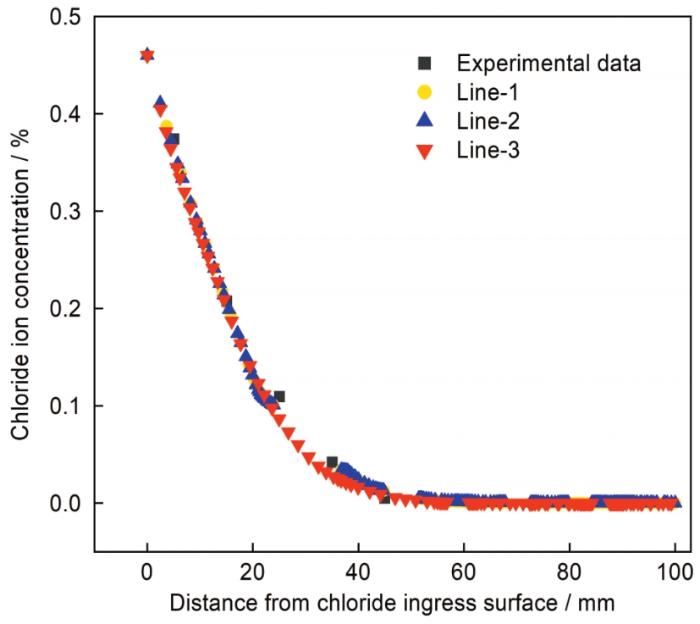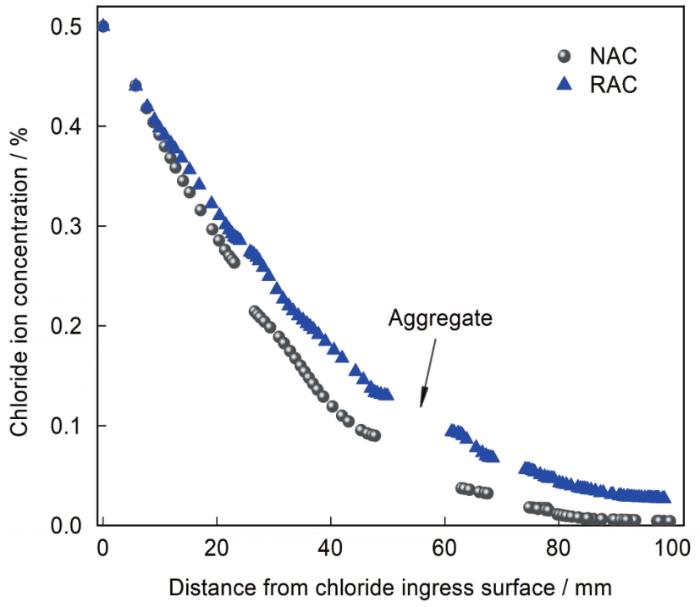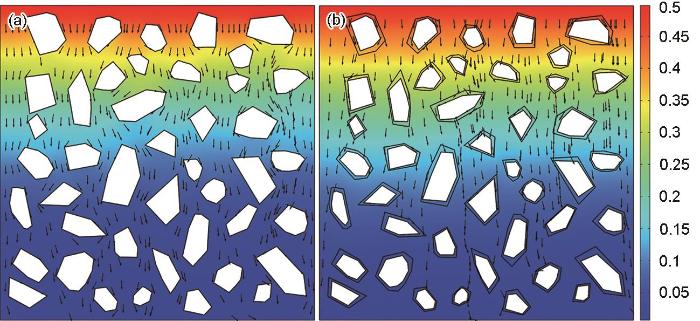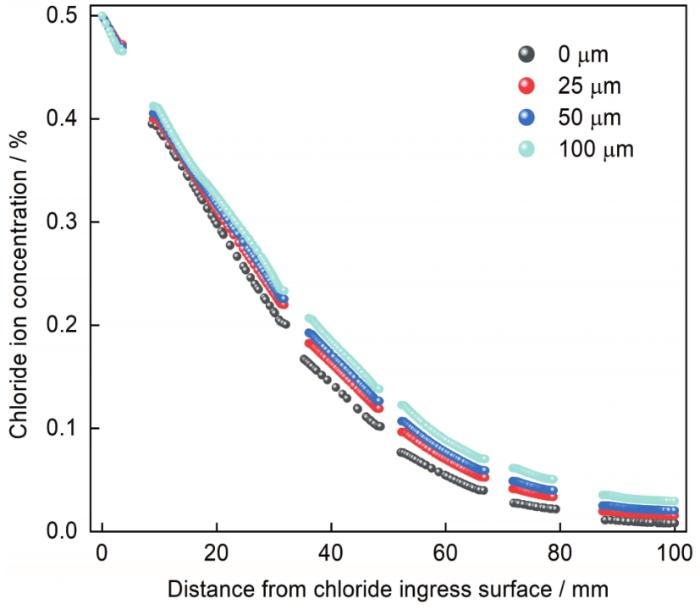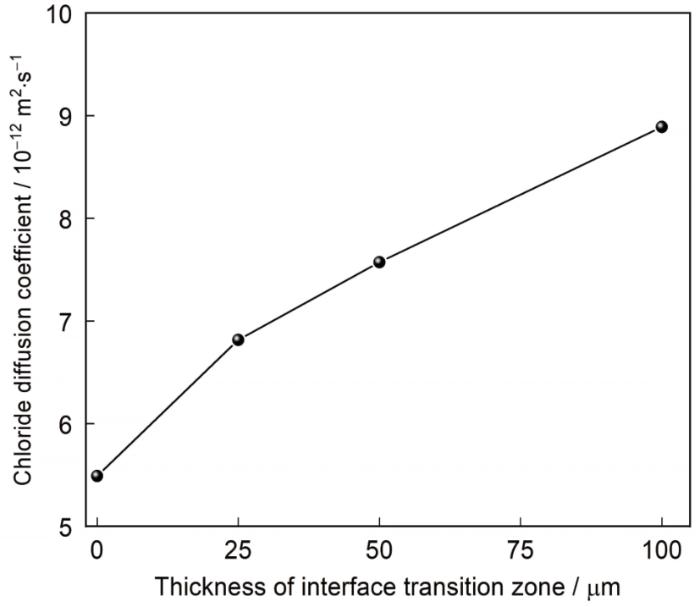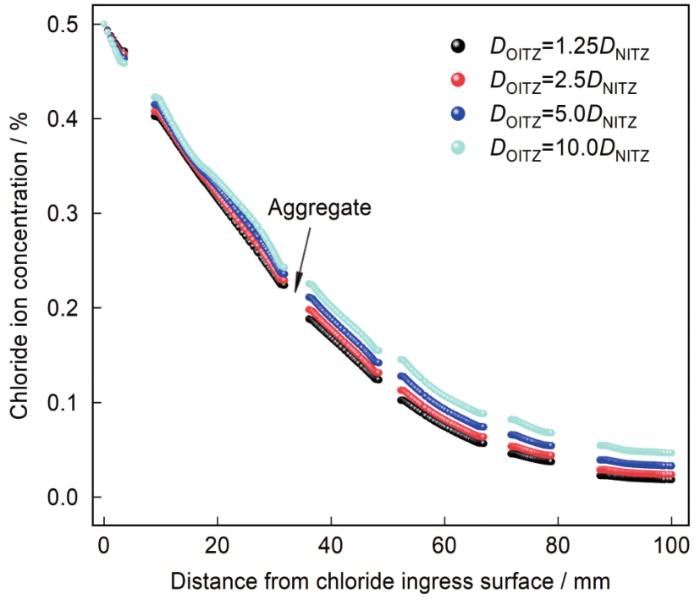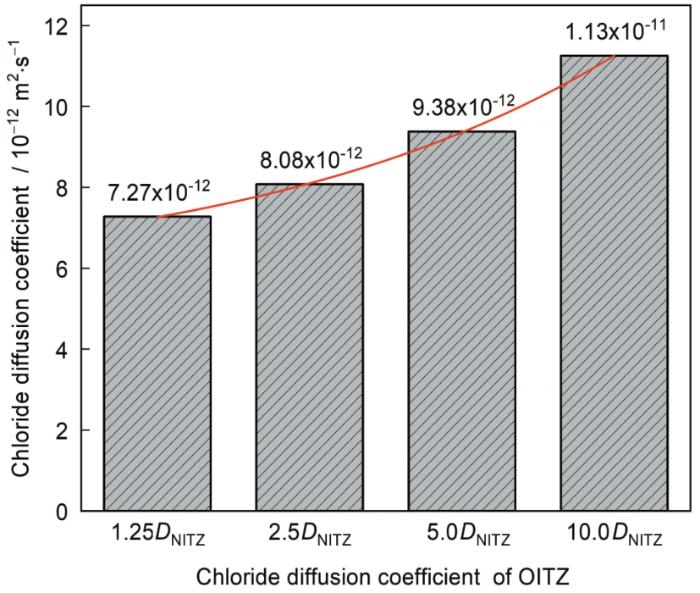虽然再生混凝土以其固废再利用的优势,不断在实际工程中应用,但仍局限于非结构构件。究其原因可能是多方面的,但耐久性问题显然是关键因素之一。在海洋环境中,Cl-侵蚀作用诱发钢筋锈,是混凝土耐久性失效的主要诱因之一。因此,研究Cl-在再生混凝土中的传输机制有着十分重要工程意义。近年来,越来越多的学者针对Cl-在再生混凝土中扩散行为做了大量的模型理论[1,2]、实验[3~6]以及数值[7~9]研究,取得显著的成果。例如:牟新宇等[1]在考虑微观孔隙结构的基础上,根据N层球夹杂理论,建立了Cl-扩散系数模型,并有效地预测Cl-在不同工况下的扩散行为。Xiao等[4]基于试验数据,验证了再生混凝土Cl-扩散行为符合Fick第二定律,并进一步研究了再生粗骨料的取代率对Cl-扩散行为的影响。Xiao等[8]与Hu等[9]提出了五相细观数值模型,并进行了参数化分析。细观上,再生混凝土是一种多相复合材料,各组分对Cl-扩散的综合性影响形成上述研究的宏观物理现象。因此,从细观层面研究各组分对Cl-扩散性能影响变得尤为重要。然而试验件又很难保证各相具备单一、稳定变量(如附着老砂浆层厚度、新老界面过渡区扩散性能与厚度、初始裂纹等),也就无法精准地预测Cl-扩散行为。而数值研究可以弥补试验研究中的不足。但前述的数值研究,大多为了简化混凝土数值模型,常常忽略了界面过渡区与附着老砂浆层厚度的随机性。本文采用蒙特卡洛法在骨料边界构造随机厚度的附着老砂浆层与界面过渡区,且厚度服从正态分布,并将再生混凝土划分为新、老砂浆和天然骨料及新、老界面过渡区五相材料。在此基础上,通过赋予各相区域不同Cl-扩散系数,研究了再生粗骨料、界面过渡区厚度、界面过渡区相对扩散系数、老砂浆相对扩散系数以及附着率对Cl-扩散行为的影响。
1 再生骨料混凝土多相细观模型
1.1 Cl-扩散理论
经过数十年的理论研究与实验论证,Cl-在混凝土中扩散行为遵循Fick第二定律已成为普遍的认识。由于细观上,再生混凝土是一种多相的复合性材料,因此,Cl-在再混凝土中扩散行为的控制方程如下式
式中,
为了后续模拟分析的方便,模型初始边界条件作出假定如下:
其中,
由于Cl-在硬化水泥砂浆中的扩散性能随着时间改变而改变,因此考虑时间因素的有效Cl-扩散系数可以表达为
1.2 二维再生骨料混凝土细观随机模型
以往为了简化混凝土数值模型,常常假定天然粗骨料为理想的圆形,并忽略了界面过渡区与附着老砂浆层厚度的随机性。但这种简化无法模拟较为真实再生骨料的细观结构。为此,在高政国和刘光廷[18]的二维混凝土随机骨料模型的基础上,采用Matlab软件进一步开发了包含粗骨料和新、老砂浆及新、老界面过渡区的多相随机细观模型。再生混凝土细观模型尺寸采用100 mm×100 mm,粗骨料采用5~20 mm的连续级配。详细流程如下:(1) 基于富勒级配理论与Walraven公式得到各级配的含量;(2) 按照粗骨料级配随机生成多边形再生粗骨料;(3) 随机再生粗骨料投放并进行碰撞检测,直到达到级配含量;(4) 多边形骨料的每个顶点沿径向,向内随机收缩一定距离
图1
图1
单个再生粗骨料细观形成
Fig.1
Mesoscopic formation of single recycled coarse aggregate: (a) a single aggregate, (b) generate old mortar, (c) generate NITZ and OITZ, (d) ITZ thickness distribution
图2
图2
再生粗骨料细观模型网格
Fig.2
Meso-model grid of recycled coarse aggregate: (a) RAC mesh model meshing, (b) details of the local grid
1.3 再生混凝土Cl- 扩散细观数值模型验证
图3
图4
2 再生混凝土Cl- 细观扩散参数化分析与讨论
2.1 天然骨料混凝土与再生骨料混凝土对比
由于粗骨料对混凝土Cl-扩散具有一定的阻碍作用,因此,首先对比研究天然骨料 (NA) 与再生骨料 (RA) 对Cl-扩散性能的影响。固定粗骨料体积率为36%,附着老砂浆率为35.5%。图5给出Cl-侵蚀5 a后Cl-浓度-深度曲线。从图5可知,在同一深度处,再生混凝土中的Cl-浓度要明显高于天然骨料混凝土,且取代率100%的再生混凝土Cl-扩散系数是天然骨料混凝土的2.31倍。因此,与天然粗骨料相比,再生粗骨料提升了Cl-在混凝土中的渗透性能。从Xiao等[4]实验数据中得到:与本节相同的骨料率下,取代率从0%到100%,相应后者的Cl-扩散系数约为前者的2.6倍。由此可见,数值模拟的结果与实验数据基本接近,再次验证了模型的相对稳定性。两者间有较小的差别,可能与再生混凝土中各相的随机性有较大关系。进一步,从图6相同位置的再生混凝土Cl-扩散路径相对较为平缓。这主要是由于附着老砂浆有利于形成Cl-快速扩散的通道,弱化了再生骨料对Cl-的阻碍作用。继而证实了附着老砂浆的存在对再生混凝土Cl-扩散性能起着重要的促进作用。
图5
图6
2.2 界面过渡区厚度的影响
相关研究表明,界面过渡区 (ITZ) 厚度与水灰比、制备工艺以及养护条件等因素相关,其取值范围在20~100 µm之间。此外界面过渡区由于壁效应,水泥水化反应不充分,会造成较高孔隙率的同时加速Cl-扩散。为此,选取了4种工况 (即ITZ厚度分别为0、25、50和100 µm),来定量研究新、旧界面过渡区厚度对Cl-扩散性能的影响,其中ITZ=0 µm表示无界面过渡区。从图7 Cl-侵蚀5 a的结果可知,随着界面过渡区厚度增加,同一深度处的Cl-浓度依次增加。此外,对比任意相邻两条浓度曲线,可知ITZ=0 µm与ITZ=25 µm的浓度曲线相距较远,这说明:虽然界面过渡区所占区域面积非常小,但界面过渡区的存在对Cl-扩散性能有着显著影响。从图8可知,随着界面过渡区厚度依次从0 µm增加到100 µm,Cl-扩散系数依次增加了24.1%、37.8%、61.9%。值得注意的是:界面过渡区厚度从0增加到25 µm时,Cl-扩散系数增长速率最高;当厚度超过25 µm后,Cl-扩散系数随界面过渡区厚度呈线性正相关。同样,Wu等[19]基于同心圆模型,理论推导出来的结果也有类似的规律。
图7
图7
不同ITZ厚度的Cl-浓度-深度曲线
Fig.7
Curves of chloride ion concentration vs depth under different ITZ thickness
图8
图8
不同ITZ厚度的Cl-扩散系数
Fig.8
Chloride diffusion coefficient under different ITZ thickness
2.3 老界面过渡区扩散系数影响
由上一节分析结果可知,界面过渡区的存在对Cl-扩散性能有着显著影响。因此本节有必要重点研究老界面过渡区扩散系数对再生混凝土Cl-扩散性能的影响。从相关学者[6,7]的研究可知,新、旧界面过渡区之间的扩散系数比值在1.0~5.0之间。为此,固定新界面过渡区的扩散系数 (DNITZ) 不变,而老界面过渡区扩散系数 (DOITZ) 作为唯一改变量。选取了DOITZ=1.25DNITZ、DOITZ=2.5DNITZ、DOITZ=5.0DNITZ和DOITZ=10.0DNITZ 4种工况。从图9 Cl-侵蚀5 a的结果可知,随着老界面过渡区的扩散系数成比例增加时,同一深度处的Cl-浓度呈现非线性递增且增幅逐渐加大。与之相同,随着老界面过渡区扩散系数从1.25DNITZ递增到5.0DNITZ时,再生混凝土Cl-扩散系数依次增加了11%、28.8%、50%,增长幅度也逐渐加大 (图10)。因此,在实际工程中,提高再生粗骨料老界面过渡区的密实度,或者清除附着老砂浆,可以降低老界面过渡区的不利影响,从而对改善再生混凝土耐久性具有一定的工程意义。
图9
图9
不同老界面过渡区扩散系数下的Cl-浓度-深度曲线
Fig.9
Curves of chloride ion concentration vs depth under different diffusion coefficients of OITZ
图10
图10
不同老界面过渡区扩散系数下的再生混凝土Cl-扩散系数
Fig.10
RAC chloride diffusion coefficient under different diffusion coefficients of OITZ
2.4 附着老砂浆的影响
由2.1节可知,附着老砂浆的存在对再生混凝土Cl-扩散性能起着重要的促进作用,而粗骨料本身对Cl-扩散性能有一定的阻碍作用。因此,有必要进一步研究在不同粗骨料体积率 (V=15%、30%、60%)、老砂浆附着率 (R=0%、10%、20%、30%、40%) 对再生混凝土扩散性能的影响。
从图11 Cl-侵蚀5 a的结果可知,当粗骨料体积率一定时,随着老砂浆含量的增加,Cl-扩散系数也随之递增且增长幅度与粗骨料体积率正相关。该结论复现了牟新宇等[1]理论模型的预测结果,同时与陈春红等[20]的实验规律以及Xiao等[21]的解析解相吻合。因此,RAC抗Cl-侵蚀能力与附着老砂浆含量呈负相关且高骨料体积率下更弱。当老砂浆附着率R=0% (即天然再生混凝土) 时,Cl-扩散系数随着粗骨料体积率增加而降低,说明天然粗骨料对Cl-渗透有一定的阻碍作用。而当老砂浆附着率R超过10%之后,RAC中Cl-扩散系数随着粗骨料体积率的增加而增加且增幅随老砂浆附着率正相关。这主要是由于部分天然骨料不断被老砂浆取代,使得粗骨料的阻碍作用逐渐减弱,而此时附着老砂浆的不利影响占主导作用。这一现象与文献[22]中的实验结果基本一致。此外,当粗骨料体积率为15%时,当老砂浆附着率从0%增长到40%时,Cl-扩散系数提高了26%;当粗骨料体积率为60%时,Cl-扩散系数提高了123%。这一现象与牟新宇等[1]所提出的理论模型预测的趋势是一致的。这主要是由于再生粗骨料体积率与老砂浆附着率二者的增加,同时提高了附着老砂浆的含量,进而降低了再生混凝土抗Cl-渗性能。因此在实际工程中,选取老砂浆附着率低的再生骨料或者清除老砂浆对于改善再生混凝土的抗Cl-侵蚀性能有着重要的指导意义。
图11
图11
老砂浆附着率、粗骨料体积率对再生混凝土扩散系数影响
Fig.11
Effect of attached mortar content and volume fraction of recycled aggregate on effective diffusion coefficient of RAC
相关研究表明,附着老砂浆的Cl-扩散系数 (DOM) 是新砂浆 (DNM) 的0.2~5.0倍。为了研究附着老砂浆扩散系数对再生混凝土Cl-扩散性能的影响。固定骨料的体积率为60%,选取了3种相对老砂浆扩散系数DOM=1.25DNM、DOM=2.5DNM、DOM=5.0DNM在不同的老砂浆附着率R (R=10%、20%、40%) 下的响应。从图12可知,当老砂浆附着率较低时,老砂浆扩散系数对再生混凝土扩散性能并不明显,当老砂浆附着率超过20%后,Cl-扩散深度随着老砂浆扩散系数增长而增加其幅度与附着老砂浆正相关。
图12
图12
老砂浆扩散系数、附着率对Cl-浓度-深度曲线影响
Fig.12
Effect of attached mortar content and diffusion coefficient of old mortar on the curve of chloride ion concentration vs depth: (a) R=10%, (b) R=20%, (c) R=40%
3 结论
(1) 附着老砂浆的存在有利于形成Cl-快速扩散的通道,弱化了粗骨料对Cl-侵蚀的阻碍作用。当粗骨料体积率为15%时,老砂浆附着率从0%增长到40%时,再生混凝土Cl-扩散系数提高了26%;而当粗骨料体积率为60%时,老砂浆附着率同样的增长,Cl-扩散系数却提高了123%。因此,RAC抗Cl-侵蚀能力与附着老砂浆含量呈负相关且高骨料体积率下更弱。
(2) 当老砂浆附着率低于10%、骨料体积率低于30%时,粗骨料的阻碍作用起主导作用,再生混凝土抗侵蚀性能与骨料体积率正相关。但当老砂浆附着率超过10%后,Cl-扩散系数随着粗骨料体积率的增加而增加且增幅与老附着率正相关。因此选取老砂浆附着率低的再生骨料或者清除老砂浆都能够有效改善再生混凝土的抗Cl-侵蚀性能。
(3) 虽然界面过渡区所占比重非常小,但随着界面过渡区厚度依次从0 µm增加到100 µm,Cl-扩散系数依次增加了24.1%、37.8%、61.9%。因此界面过渡区的影响不容忽视,在实际工程中,降低界面过渡区的孔隙率,提高其抗Cl-侵蚀性能,能够明显提升再生混凝土的抗Cl-侵蚀性能。
参考文献
Prediction of effective chloride diffusion coefficient of recycled aggregate concrete based on multiscale analysis
[J].
基于多尺度分析的再生混凝土有效Cl-扩散系数预测
[J].
Multi-scale prediction of the effective chloride diffusion coefficient of concrete
[J].
Corrosion characteristics of carbon steel in simulated marine atmospheres
[J].
基于海洋大气环境因素影响下的碳钢腐蚀特征研究
[J].
Test and prediction of chloride diffusion in recycled aggregate concrete
[J].
Influence of the incorporation of recycled coarse aggregate on water absorption and chloride penetration into concrete
[J].
Influence of Cl- concentration on corrosion behavior of reinforced concrete in soil
[J].
Cl-浓度对钢筋混凝土在土壤中腐蚀行为的影响
[J].针对环境中Cl<sup>-</sup>侵蚀钢筋混凝土构筑物造成混凝土及其内部钢筋结构发生破坏的问题,采用数值模拟的方式研究了Cl<sup>-</sup>对钢筋混凝土腐蚀行为的影响。结果表明,钢筋混凝土在受到Cl<sup>-</sup>侵蚀时,试件靠近侵蚀界面的位置Cl<sup>-</sup>浓度较大;随着实验的进行,试件内部Cl<sup>-</sup>含量不断增加,且钢筋表面Cl<sup>-</sup>浓度差逐渐增大。混凝土试件内部的钢筋腐蚀深度与Cl<sup>-</sup>含量相关,钢筋表面Cl<sup>-</sup>浓度大的位置腐蚀较为严重。此外Cl<sup>-</sup>浓度范围在100~600 mol/m<sup>3</sup>之间时,Cl<sup>-</sup>浓度与钢筋钝化时间T满足四次函数关系,与钢筋表面的电位E之间满足五次函数关系。
Probability analysis on service life prediction of reinforced concrete structures
[J].
基于概率分析的钢筋混凝土结构服役寿命预测研究
[J].采用Monte Carlo法建立了钢筋混凝土结构耐久性失效的概率模型,研究了钢筋混凝土结构服役寿命概率分布。结果表明,Monte Carlo模拟次数为10000次时,既节约计算资源又满足计算精度。采用概率方法 (p<sub>fmax</sub>=5%和10%) 计算的结构服役寿命比用确定方法计算的服役寿命短,确定性模型低估了Cl<sup>-</sup>侵蚀引起的耐久性失效。对水灰比、混凝土保护层厚度、粉煤灰掺量、表面Cl<sup>-</sup>浓度、临界Cl<sup>-</sup>浓度参数化分析结果表明,保护层厚度对服役寿命影响最为显著;同时,服役寿命长的结构,其安全储备期也较长,一般安全储备期在5~10 a之间。本文提出的服役寿命预测模型为钢筋混凝土结构的修复、健康监测提供了理论依据。
FEM simulation of chloride diffusion in modeled recycled aggregate concrete
[J].
Five-phase modelling for effective diffusion coefficient of chlorides in recycled concrete
[J].With the utilisation of recycled aggregate concrete (RAC) in building construction, the durability of this material requires particular attention, especially in terms of chloride penetration. This paper presents a numerical study on the chloride diffusion mechanism within RAC. Considering the random distribution of recycled coarse aggregates (RCA), a five-phase RAC model – including new mortar, adherent old mortar, new interfacial transition zone (ITZ), old ITZ and original natural coarse aggregates – is proposed to predict the effective diffusion coefficient of chlorides in RAC. The parametric studies, based on a series of critical factors (i.e. volume fraction of RCA, adhesive ratio of old mortar, chloride diffusivity of adherent old mortar, thicknesses of old and new ITZs and chloride diffusivity of old and new ITZs), reveal the properties of each phase and their individual impact on the effective diffusion coefficient of chlorides in RAC. The results obtained indicate that, interestingly, the effective diffusion coefficient tends to vary in terms of its relationships with high-quality adherent old mortar, lower adhesive ratio of old mortar, smaller thickness of ITZs and relatively superior chloride penetration resistance of ITZs, which cannot be found from existing models and experiments.
Laboratory test and geochemical modeling of cement paste degradation, in contact with ammonium chloride solution
[J].Concrete tanks, in coke wastewater treatment plants, are exposed to aggressive wastewater with high ammonium and chloride content, deteriorating the concrete binder. Due to this, toxic compounds may migrate to the environment. The results of the experimental work presented confirmed the changes in the phase, microstructure and concentration of chlorides caused by the penetration of NH4Cl into the hardened cement paste in dry conditions. Geochemical modeling of the interactions between the aggressive solution, the cement stone matrix and the pore water was performed in order to track the destruction process effects. The results are useful for condition assessment of the structures operating under occasional immersion.
Multiphysics and multiscale modeling of coupled transport of chloride ions in concrete
[J].Chloride ions (Cl−)-induced corrosion is one of the main degradation mechanisms in reinforced concrete (RC) structures. In most situations, the degradation initiates with the transport of Cl− from the surface of the concrete towards the reinforcing steel. The accumulation of Cl− at the steel-concrete interface could initiate reinforcement corrosion once a threshold Cl− concentration is achieved. An accurate numerical model of the Cl− transport in concrete is required to predict the corrosion initiation in RC structures. However, existing numerical models lack a representation of the heterogenous concrete microstructure resulting from the varying environmental conditions and the indirect effect of time dependent temperature and relative humidity (RH) on the water adsorption and Cl− binding isotherms. In this study, a numerical model is developed to study the coupled transport of Cl− with heat, RH and oxygen (O2) into the concrete. The modeling of the concrete microstructure is performed using the Virtual Cement and Concrete Testing Laboratory (VCCTL) code developed by the U.S. National Institute of Standards and Technology (NIST). The concept of equivalent maturation time is utilized to eliminate the limitation of simulating concrete microstructure using VCCTL in specific environmental conditions such as adiabatic. Thus, a time-dependent concrete microstructure, which depends on the hydration reactions coupled with the temperature and RH of the environment, is achieved to study the Cl− transport. Additionally, Cl− binding isotherms, which are a function of the pH of the concrete pore solution, Cl− concentration, and weight fraction of mono-sulfate aluminate (AFm) and calcium-silicate-hydrate (C-S-H), obtained from an experimental study by the same authors are utilized to account for the Cl− binding of cement hydration products. The temperature dependent RH diffusion was considered to account for the transport of Cl− with moisture transport. The temperature and RH diffusion in the concrete domain, composite theory, and Cl− binding and water adsorption isotherms are used in combination, to estimate the ensuing Cl− diffusion field within the concrete. The coupled transport process of heat, RH, Cl−, and O2 is implemented in the Multiphysics Object-Oriented Simulation Environment (MOOSE) developed by the U.S. Idaho National Laboratory (INL). The model was verified and validated using data from multiple experimental studies with different concrete mixture proportions, curing durations, and environmental conditions. Additionally, a sensitivity analysis was performed to identify that the water-to-cement (w/c) ratio, the exposure duration, the boundary conditions: temperature, RH, surface Cl− concentration, Cl− diffusion coefficient in the capillary water, and the critical RH are the important parameters that govern the Cl− transport in RC structures. In a case study, the capabilities of the developed numerical model are demonstrated by studying the complex 2D diffusion of Cl− in a RC beam located in two different climatic regions: warm and humid weather in Galveston, Texas, and cold and dry weather in North Minnesota, Minnesota, subjected to time varying temperature, RH, and surface Cl− concentrations.
Study on concrete deterioration in different NaCl-Na2SO4 solutions and the mechanism of Cl- diffusion
[J].The diffusion of sulfate (SO42−) and chloride (Cl−) ions from rivers, salt lakes and saline soil into reinforced concrete is one of the main factors that contributes to the corrosion of steel reinforcing bars, thus reducing their mechanical properties. This work experimentally investigated the corrosion process involving various concentrations of NaCl-Na2SO4 leading to the coupled erosion of concrete. The appearance, weight, and mechanical properties of the concrete were measured throughout the erosion process, and the Cl− and SO42− contents in concrete were determined using Cl− rapid testing and spectrophotometry, respectively. Scanning electron microscopy, energy spectrometry, X-ray diffractometry, and mercury porosimetry were also employed to analyze microstructural changes and complex mineral combinations in these samples. The results showed that with higher Na2SO4 concentration and longer exposure time, the mass, compressive strength, and relative dynamic elastic modulus gradually increased and large pores gradually transitioned to medium and small pores. When the Na2SO4 mass fraction in the salt solution was ≥10 wt%, there was a downward trend in the mechanical properties after exposure for a certain period of time. The Cl− diffusion rate was thus related to Na2SO4 concentration. When the Na2SO4 mass fraction in solution was ≤5 wt% and exposure time short, SO42− and cement hydration/corrosion products hindered Cl− migration. In a concentrated Na2SO4 environment (≥10 wt%), the Cl− diffusion rate was accelerated in the later stages of exposure. These experiments further revealed that the Cl− migration rate was higher than that of SO42−.
Prediction of diffusivity of concrete based on simple analytic equations
[J].
Estimation of chloride diffusion coefficient from water permeability test of cementitious materials
[J].
Physical properties of cement paste
[A].
Multi-scale physicochemical modeling of soil-cementitious material interaction
[J].
Effect of crack and damaged zone on chloride penetration in recycled aggregate concrete: a seven-phase mesoscale numerical method
[J].
Two-dimensional random aggregate structure for concrete
[J].
二维混凝土随机骨料模型研究
[J].
Multiscale digital-image driven stochastic finite element modeling of chloride diffusion in recycled aggregate concrete
[J].
Effect of attached mortar content on chloride ion erosion resistance of recycled concrete
[J].
黏附砂浆含量对再生混凝土抗Cl-侵蚀性能影响
[J].
Properties of interfacial transition zones in recycled aggregate concrete tested by nanoindentation
[J].







